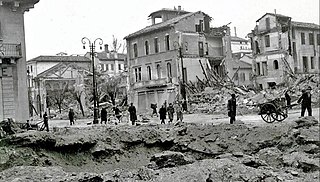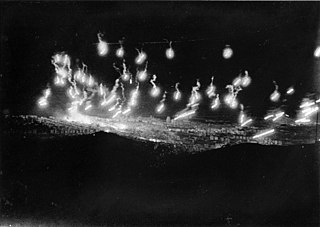1943
The situation changed in early 1943, when Cagliari came within range of the USAAF bombers operating from the newly conquered airfields in Algeria and later Tunisia. In order to interdict Axis air operations against Allied-controlled ports in French North Africa, the Sardinian airfields became a prime target for the Allied air forces; at the same time, the escalation of air raids on Sardinia was part of the Allied effort to mislead the Axis high commands into thinking that this island, rather than Sicily, would be the next target for Allied invasion.
On 7 February 1943, 51 Boeing B-17 Flying Fortress and Martin B-26 Marauder bombers dropped 81 tons of bombs on the Elmas airfield, destroying ten Axis aircraft on the ground and killing 31 servicemen. Some bombs fell on the suburbs of Cagliari, killing two civilians; four bombers were shot down by anti-aircraft fire and by Italian and German fighter planes, four of which (two Italian and two German) were downed in turn. In the following night, sixteen Vickers Wellington of the RAF also attacked the airfields. [2] [3] [4]
On 17 February, 43 B-17s attacked the Elmas airfield with fragmentation bombs, but heavy cloud cover caused most of the bombs to miss the target and hit the city; while damage to buildings was relatively light, the fragmentation bombs killed some 200 civilians, in addition to 44 soldiers. [5] [6] [7] [8] [9] [10]
On 26 February, nineteen B-17 bombers dropped fifty tons of bombs over the port and the Elmas air base; many of the bombs also fell on the city, causing severe damage and casualties in the Bonaria, Castello, Stampace and Marina districts. At least 73 civilians were killed, but some estimates place the death toll at over 200. [11] [12] [13] [14]
Two days later, 47 B-17s dropped 123 tons of bombs on the harbour and the Elmas airfield, hitting the targets (one steamer was sunk and another damaged in the port), the railway station, and part of the city, especially the Stampace district. According to data of the Prefecture of Cagliari, the two raids on 26 and 28 January caused 600 deaths: 411 or 416 civilians and 189 servicemen. After these raids, damage was widespread in the city: on 4 March the prefect of Cagliari, Leone Leone, wrote in his report that "…there is not a single street left without destroyed homes, and in many parts destruction is complete…"; most of the population left the city, and those who remained spent most of their time in air raid shelters. State offices were also relocated to Sassari, Oristano and other towns. [15] [16] [17] [18] [19] [20]
On 31 March 1943, 27 B-17s of the 12th USAAF attacked the harbour, dropping 65 tons of bombs. The target was hit, sinking two steamers at their moorings, but many bombs also fell on the city, killing sixty civilians and wounding 52. Three bombers were shot down and four damaged by Italian fighter planes, three of which were shot down in return. [21] [22] [23] [24]
On 14 April, the Elmas airfield was bombed by 23 aircraft of the 12th USAAF. On 13 May, Cagliari suffered the heaviest raid of the war: 197 B-17 bombers, escorted by 186 fighters, dropped 404 tons of bombs over the city. Main objectives were the port and the marshalling yard, but according to some sources part of the bombers were also specifically tasked with attacking the city itself, in order to weaken the morale of the population. Indeed, this raid caused widespread damage to the entire city. At the same time, thousands of propaganda leaflets were dropped, denouncing the alliance between Italy and Germany and urging the population to pressure the government to make peace with the Allies. The submarine Mocenigo and a merchant ship were sunk in the harbour. The Italian and German air forces claimed seven B-17s shot down, and lost six fighters in return. On the following night, Vickers Wellington bombers of the Northwest African Strategic Air Force dropped a further fifty tons of bombs. The 13 May raid was the most destructive attack suffered by Cagliari, but civilian casualties were relatively low (estimates vary between thirty and sixty) as most of the population had already left the city. [25] [26] [27] [28] [29]
After this raid, Cagliari had become a ruined, deserted city; by June 1943, less than 10,000 of Cagliari's pre-war population of 100,000 were still living in the city. [30] On 16 May 1943 capitano di fregata Francesco Murzi, commander of the 7th Submarine Group, reported that "…the city is almost completely destroyed. Only a few homes in the suburbs are still standing (…) All public services are interrupted. The supply of electricity will become possible in fifteen days, but only in certain areas of military importance. The problem of water supply is very serious, as (…) all the main pipes have been destroyed (…) The city is almost completely deserted". [31] Further raids were carried out on 31 June (by twenty RAF bombers), 2 July (by twenty British bombers), 3 July (by the RAF), 4 July (by B-17 bombers of the USAAF) and 20 July (by the RAF), usually targeting the port and the marshalling yard. These attacks, however, were not as heavy as the previous ones, as by this time the Allied air forces in the Mediterranean were focused on the invasion of Sicily. [32]



















